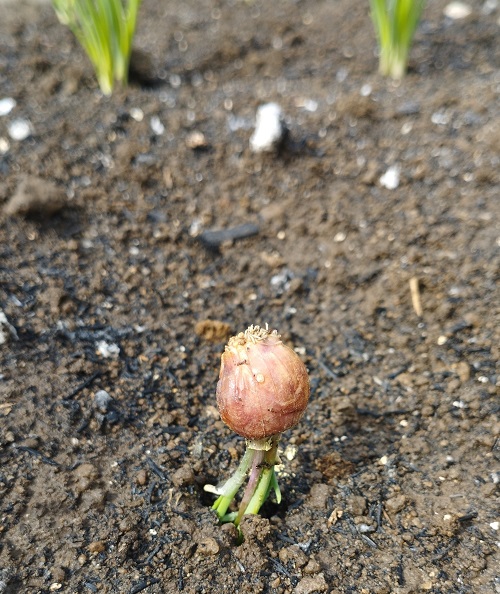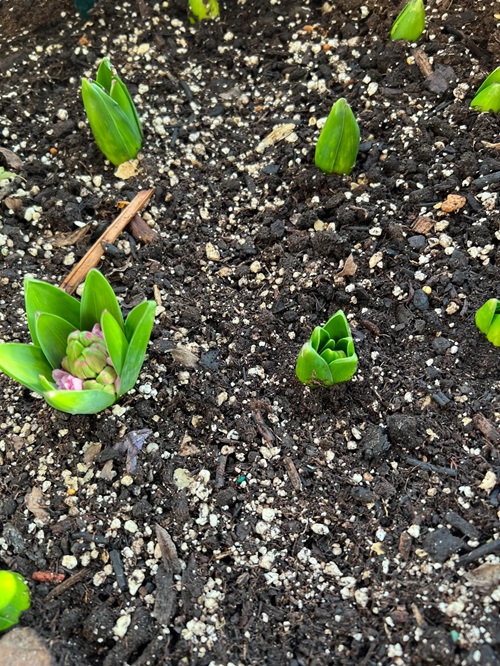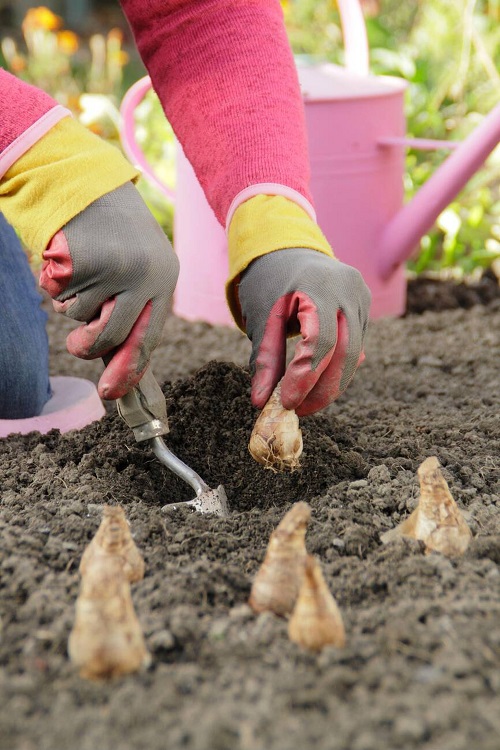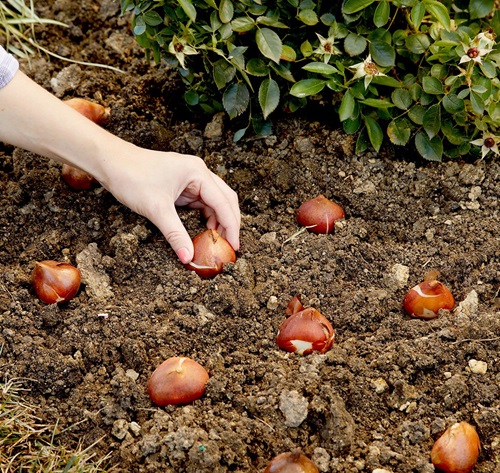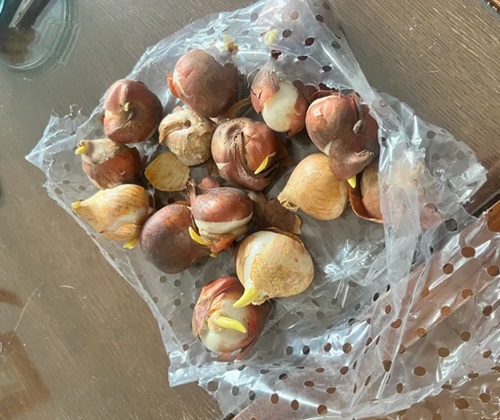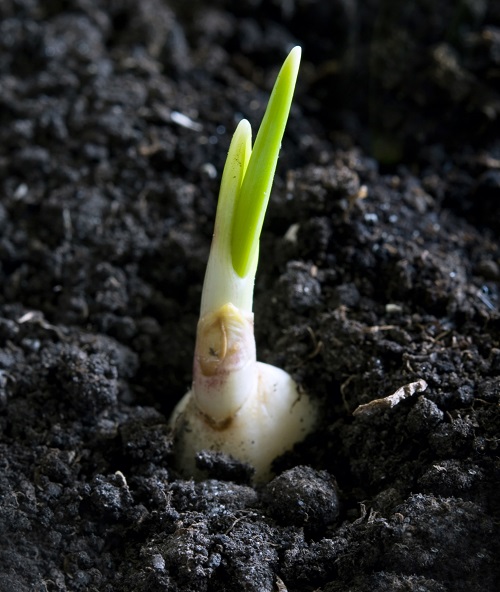Here are the Biggest Bulb Planting Mistakes Everyone Should Avoid if they need a healthy plant full of pretty flowers!
Planting bulbs is quite a different story when it comes to gardening. And typically, you won’t realize what’s wrong until it’s too late! We share the biggest bulb-planting mistakes everyone should avoid this fall and winter for a garden filled with the prettiest blooms.
Bulb Planting Mistakes Everyone Should Avoid
1. Placing your Bulb Upside Down
Bulbs usually have a pointed conical protrusion indicating the bulb’s head or top. When planting, ensure the top is the part above the soil looking upwards. If planted the other way around, the shoot will struggle to reach and push through the soil below.
Most true bulbs, like tulips and daffodils, have a pointed tip that should face up, but there are exceptions. Some bulbs, like crocus and snowdrops, can be planted either way.
2. Bulbs have Expired
Bulbs have a viability period that differs from plant to plant. In most cases, if the bulb has surpassed its viability period, it won’t shoot properly or may even remain dormant forever! They are also prone to decay, infestations, and environmental damage from extremities.
Don’t let your bulbs hit the expiry date. Most bulbs can be stored for up to a year but perform best when grown within six months.
3. Planting in the Wrong Season

Perfect timing is true for most things in life, including bulb planting! Some need extreme cold and should be sown in winter. And some others may need to be planted in summer, spring, or autumn! Know these details before you begin digging up your garden.
Tender bulbs like gladiolus, Stargazer lily, Martagon lily, dahlia, and calla should be planted in spring after the risk of frost has passed.
To know when to plant your bulb, check your plant’s climate and temperature needs according to the USDA zone you belong to. Here are the timings best suited for a few common bulbous plants.
- Mid to late autumn for tulip bulbs
- Late summer to early fall for iris bulbs
- Very early spring or late fall for alliums
- Mid fall to winter for amaryllis
4. Not Preparing the Soil
Different bulbs flourish in different types of soil. Tulips grow best in well-drained, slightly alkaline soil, while hyacinth bulbs need a slightly more acidic medium. And even if you’ve got the soil type down, you still need to prepare it for sowing your bulb.
If your bulb needs well-draining soil with ample airflow and rich organic matter, supplement your medium with sandy or gravel soil to add texture and improve airflow. Then, add organic materials such as cocopeat or mulch to make it nutritionally dense.
This will be specific to each type of plant, so do your homework before you start the process!
5. You Got the Wrong Depth
This is the biggest killer of bulbous plants and floral dreams! You may think throwing a bulb in a hole in the ground will grow it into a thriving plant. But without planting your bulb at the right depth—not too shallow, not too deep—you can kiss your flowers goodbye.
As a general rule, plant the bulb at a depth of 2-3 times its size. However, soil type, texture, and other environmental conditions also influence how deep you sow it. Check out our detailed guide on planting depths for different bulbs.
6. Overcrowded Bulbs
Another big mistake noob gardeners commit is ignoring space needs when planting bulbs. Planting is just the initial stage. Once the roots spread and the bulb starts pushing out leaves and branches, it will need more room. You have to account for space while planting.
For small bulbs like crocus and squills, which will also become small plants with shallow spread, 3-4 inches of space works. However, with larger candidates like tulips, daffodils, and hyacinths, aim to plant them at least 5-6 inches apart.
7. Overwatering Bulbs
A grave mistake most gardeners make when bulb planting is giving them too much water. They continuously water the bulb to try and speed up the growing process, which does more harm than good.
Granted, you need moist soil to keep the bulb alive and healthy, but you don’t need to overwater it! The best way is to water the bulb only when the soil feels dry, usually once in 7-10 days.
Overwatering can cause decay, root rot, and a lack of airflow, eventually killing the bulb before it can even dream about sprouting!
8. Planting Too Much Shade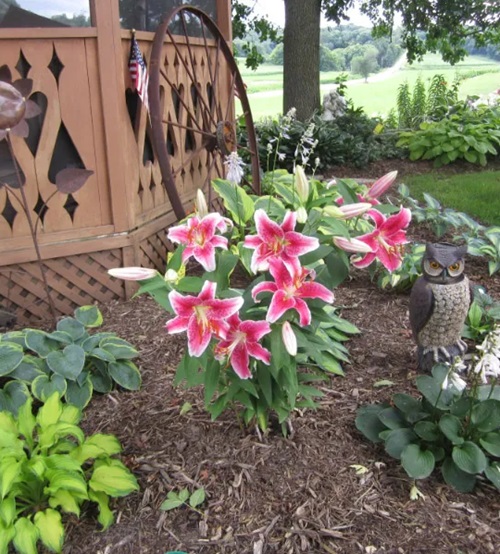
Bulbs need ample sunshine to thrive. Surprised? Just because they are underground doesn’t mean the sun’s goodness doesn’t reach them. They flourish from the sun’s heat, especially if planted in cooler weather. This keeps them insulated and protected from frost.
Plant them where they can get 6-8 hours of full sun or partial shade. Planting them in a spot that remains shaded, damp, and stuff makes them vulnerable to fungal diseases and even destroys their future aesthetic appeal.
9. Improper Bulb Storage
Bulbs go bad if stored incorrectly. Most bulbs prefer a cool, dry environment, such as a basement or garage, as long as it doesn’t freeze there. One common mistake gardeners make is storing bulbs too soon after digging them up.
They need to dry out for a couple of weeks before being packed up for storage. Or to store them carelessly in damp, humid spaces. This can also cause mold and disease. Go with a mesh bag or open container to allow air to circulate, and avoid storing them in plastic bags!
Finally, gardeners often forget to label their bulbs, making it difficult to remember what type of flower they will produce the following season. Don’t skip the labels!
10. Not Naturalizing the Bulbs
Naturalizing bulbs is more of a choice than a mistake, but if you ask us, skipping it would be a folly on your part. It involves planting bulbs in areas where they can self-seed and multiply through the years, mimicking their natural growth.
Once mature, naturalized bulbs need little care. They will come up year after year without any need for replanting. However, not all bulbs are suitable for naturalizing: daffodils, alliums, and fritillaria are a few examples of ones that reseed and spread vigorously.


